The Effect of Laser Shock Processing on the Anti-Corrosion Performance of LENS-Fabricated Ti-6Al-4V Alloy
Abstract
1. Introduction
2. Materials and Methods
3. Results
3.1. Microstructural Characterisation
3.2. Electrochemical Behaviour
3.3. Oxidation Behaviour
3.4. Laser Shock Processing
3.4.1. Influence of Laser Peening on Microhardness and Surface Roughness
| before LSP | after LSP | |||
|---|---|---|---|---|
| 249 J/mm3 | 90% | 95% | 99% | |
| Maximum | 399 | 438 | 427 | 425 |
| Minimum | 303 | 356 | 359 | 352 |
| Average | 375 | 384 | 386 | 389 |
| STD dev | 17 | 16 | 12 | 16 |
3.4.2. Influence of Laser Peening on Electrochemical Response
3.4.3. Influence of Laser Peening on Oxidation Behaviour
4. Conclusions
- The energy input, measured as the energy density, had a positive effect on the microstructural evolution as it reduced the formation of defects, which resulted in improved mechanical properties.
- The energy density of 249 J/mm3 used to fabricate the Ti-6Al-4V samples was seen to be sufficient to treat the alloy and evolve microstructures that showed beneficial properties.
- The typical microstructure observed for the Ti-6Al-4V alloy was reported to be the fine acicular α’ martensitic microstructure, which was reported to promote improved corrosion resistance.
- Optimum corrosion and oxidation behaviour was observed with the alloy produced at the optimised parameters that gave an energy density of 249 J/mm3. Therefore, it is recommended for the energy density to be kept at moderate levels to treat the Ti-6Al-4V alloy and ensure improved corrosion and oxidation response.
- The use of LSP as a surface treatment technique was demonstrated to yield improvements in the mechanical properties, such as the surface hardness profile, through the introduction of compressive residual stresses. It is postulated that, through this, the fatigue properties could potentially be improved as well.
- The application of the LSP technique at varying overlaps demonstrated the strong capability of the technique for the improvement of the corrosion performance of the Ti-6Al-4V alloy, as well as the mitigation of pitting corrosion.
- The use of LSP overlaps should be maintained at a moderate level not exceeding 95%, to minimise the effects on the surface properties, but still optimising the material properties, such as the corrosion rate and polarisation resistance, and to promote an improved oxidation rate and stability during operation at elevated temperatures up to 500 °C.
Author Contributions
Funding
Data Availability Statement
Acknowledgments
Conflicts of Interest
References
- Oliari, S.H.; D’Oliveira, A.S.C.M.; Schulz, M. Additive Manufacturing of H11 with Wire-Based Laser Metal Deposition. Soldag. Inspeção 2017, 22, 466–479. [Google Scholar] [CrossRef]
- Sibisi, P.N.; Popoola, A.P.I.; Arthur, N.K.K.; Pityana, S.L. Review on Direct Metal Laser Deposition Manufacturing Technology for the Ti-6Al-4V Alloy. Int. J. Adv. Manuf. Technol. 2020, 107, 1163–1178. [Google Scholar] [CrossRef]
- Inagaki, I.; Shirai, Y.; Takechi, T.; Ariyasu, N. Application and Features of Titanium for the Aerospace Industry. 2014. Available online: https://www.nipponsteel.com/en/tech/report/nssmc/pdf/106-05.pdf (accessed on 16 April 2023).
- Sharif, S.; Rahim, E.A.; Sasahara, H. Machinability of Titanium Alloys in Drilling. In Titanium Alloys—Towards Achieving Enhanced Properties for Diversified Applications; Intech: Sydney, Australia, 2013. [Google Scholar]
- Revankar, G.D.; Shetty, R.; Rao, S.S.; Gaitonde, V.N. Analysis of Surface Roughness and Hardness in Titanium Alloy Machining with Polycrystalline Diamond Tool under Different Lubricating Modes. Mater. Res. 2014, 14, 1010–1022. [Google Scholar] [CrossRef]
- Shunmugavel, M.; Polishetty, A.; Littlefair, G. Microstructure and Mechanical Properties of Wrought and Additive Manufactured Ti-6Al-4V Cylindrical Bars. Procedia Technol. 2015, 20, 231–236. [Google Scholar] [CrossRef]
- Peters, M.; Kumpfert, J.; Ward, C.H.; Leyens, C. Titanium Alloys for Aerospace Applications. In Titanium and Titanium Alloys: Fundamentals and Applications; WILEY-VCH Verlag GmbH & Co. KGaA: Weinheim, Germany, 2001; pp. 333–350. [Google Scholar]
- Neikter, M.; Åkerfeldt, P.; Pederson, R.; Antti, M.L.; Sandell, V. Microstructural Characterization and Comparison of Ti-6Al-4V Manufactured with Different Additive Manufacturing Processes. Mater. Charact. 2018, 143, 68–75. [Google Scholar] [CrossRef]
- Casadebaigt, A.; Monceau, D.; Hugues, J. High Temperature Oxidation of Ti-6Al-4V Alloy Fabricated by Additive Manufcturing: Influence on Mechanical Properties. In MATEC Web of Conferences; EDP Sciences: Les Ulis, France, 2020; Volume 321, p. 03006. [Google Scholar]
- Eylon, D.; Fujishiro, S.; Postans, P.J.; Froes, F.H. High-Temperature Titanium Alloys: A Review. J. Metals 1984, 36, 55–62. [Google Scholar] [CrossRef]
- Gaddam, R.; Sefer, B.; Pederson, R.; Antti, M.L. Study of Alpha-Case Depth in Ti-6Al-2Sn-4Zr-2Mo and Ti-6Al-4V. IOP Conf. Ser. Mater. Sci. Eng. 2013, 48, 012002. [Google Scholar] [CrossRef]
- Sefer, B.; Roa, J.J.; Mateo, A.; Pederson, R.; Antti, M.L. Evaluation of the Bulk and Alpha-Case Layer Properties in Ti-6Al-4V at Micro- and Nano-Metric Length Scale. In Proceedings of the 13th World Conference on Titanium; John Wiley & Sons, Inc.: Hoboken, NJ, USA, 2016; pp. 1619–1624. [Google Scholar]
- Liao, Y.; Ye, C.; Cheng, G.J. A Review: Warm Laser Shock Peening and Related Laser Processing Technique. Opt. Laser Technol. 2016, 78, 15–24. [Google Scholar] [CrossRef]
- Sun, R.; Li, L.; Zhu, Y.; Guo, W.; Peng, P.; Cong, B.; Sun, J.; Che, Z.; Li, B.; Guo, C.; et al. Microstructure, Residual Stress and Tensile Properties Control of Wire Arc Additive Manufactured 2319 Aluminum Alloy with Laser Shock Peening. J. Alloys Compd. 2018, 747, 255–265. [Google Scholar] [CrossRef]
- Guo, W.; Wang, H.; Peng, P.; Song, B.; Zhang, H.; Shao, T.; Huan, H.; Qiao, H.; Qu, G.; Zhu, D.; et al. Effect of Laser Shock Processing on Oxidation Resistance of Laser Additive Manufactured Ti6Al4V Titanium Alloy. Corros. Sci. 2020, 170, 108655. [Google Scholar] [CrossRef]
- Peyre, P.; Fabbro, R. Laser Shock Processing: A Review of the Physics and Applications. Opt. Quantum Electron. 1995, 27, 1213–1229. [Google Scholar]
- Clauer, A.H.; Peening, L.S. Review: Laser Shock Peening, the Path to Production. Metals 2019, 9, 626. [Google Scholar] [CrossRef]
- Sano, Y.; Akita, K.; Masaki, K.; Ochi, Y.; Altenberger, I.; Scholtes, B. Laser Peening without Coating as a Surface Enhancement Technology. Pulse 2006, 100, 250mJ. [Google Scholar] [CrossRef]
- Sano, Y. Quarter Century Development of Laser Peening without Coating. Metals 2020, 10, 152. [Google Scholar] [CrossRef]
- Shukla, P.P.; Swanson, P.T.; Page, C.J. Laser Shock Peening and Mechanical Shot Peening Processes Applicable for the Surface Treatment of Technical Grade Ceramics: A Review. J. Eng. Manuf. 2013, 228, 639–652. [Google Scholar] [CrossRef]
- Zhang, Q.; Duan, B.; Zhang, Z.; Wang, J.; Si, C. Effect of ultrasonic shot peening on microstructure evolution and corrosion resistance of selective laser melted Tie6Ale4V alloy. J. Mater. Res. Technol. 2021, 11, 1090–1099. [Google Scholar] [CrossRef]
- Agrawal, R.K.; Pandey, V.; Barhanpurkar-Naik, A.; Wani, M.R.; Chattopadhyay, K.; Singh, V. Effect of Ultrasonic Shot Peening Duration on Microstructure, Corrosion Behavior and Cell Response of CP-Ti. Ultrasonics 2020, 104, 106110. [Google Scholar] [CrossRef]
- Crespo, L.; Hierro-Oliva, M.; Barriuso, S.; Vadillo-Rodríguez, V.; Montealegre, M.Á.; Saldaña, L.; Gomez-Barrena, E.; González-Carrasco, J.L.; González-Martín, M.L.; Vilaboa, N. On the Interactions of Human Bone Cells with Ti6Al4V Thermally Oxidized by Means of Laser Shock Processing. Biomed. Mater. 2016, 11, 015009. [Google Scholar] [CrossRef]
- Kanjer, A.; Lavisse, L.; Optasanu, V.; Berger, P.; Gorny, C.; Peyre, P.; Herbst, F.; Heintz, O.; Geoffroy, N.; Montesin, T.; et al. Effect of Laser Shock Peening on the High Temperature Oxidation Resistance of Titanium. Surf. Coat. Technol. 2017, 326, 146–155. [Google Scholar] [CrossRef]
- Berthe, L.; Fabbro, R.; Peyre, P.; Tollier, L.; Bartnicki, E. Shock Waves from a Water-Confined Laser-Generated Plasma. J. Appl. Phys. 1997, 82, 2826–2832. [Google Scholar] [CrossRef]
- Maawad, E.; Sano, Y.; Wagner, L.; Brokmeier, H.-G.; Genzel, C. Investigation of Laser Shock Peening Effects on Residual Stress State and Fatigue Performance of Ttanium Aloys. Mater. Sci. Eng. A 2012, 82–91, 536. [Google Scholar]
- Karthik, D.; Swaroop, S. Laser Peening without Coating Induced Phase Transformation and Thermal Relaxation of Residual Stresses in AISI 321 Steel. Surf. Coat. Technol. 2016, 291, 161–171. [Google Scholar] [CrossRef]
- Sathyajith, S.; Kalainathan, S.; Swaroop, S. Laser Peening without Coating on Aluminum Alloy Al-6061-T6 Using Low Energy Nd:YAG Laser. Opt. Laser Technol. 2013, 45, 389–394. [Google Scholar] [CrossRef]
- Sano, Y.; Masaki, K.; Gushi, T.; Sano, T. Improvement in Fatigue Performance of Friction Stir Welded A6061-T6 Aluminum Alloy by Laser Peening without Coating. Mater. Des. 2012, 36, 809–814. [Google Scholar] [CrossRef]
- Attar, H.; Bonisch, M.; Calin, M.; Zhang, L.C.; Scudino, S.; Eckert, J. Selective Laser Melting of In Situ Titanium-Titanium Boride Composites: Processing, Microstructure and Mechanical Properties. Acta Mater. 2014, 76, 13–22. [Google Scholar] [CrossRef]
- Arthur, N.K.K.; Siyasiya, C.W.; Pityana, S.L.; Tlotleng, M. Microstructural Response of Ti6Al4V ELI Alloyed with Molybdenum by Direct Energy Deposition. J. Mater. Eng. Perform. 2021, 30, 5455–5465. [Google Scholar] [CrossRef]
- Arthur, N.K.K.; Pityana, S.L. Microstructure and Material Properties of LENS Fabricated Ti6Al4V Components. R D J. S. Afr. Inst. Mech. Eng. 2018, 34, 33–36. [Google Scholar]
- Arthur, N.K.K. Laser Based Manufacturing of Ti6Al4V: A Comparison of LENS and Selective Laser Melting. Mater. Sci. Forum 2019, 950, 44–49. [Google Scholar] [CrossRef]
- Vrancken, B.; Thijs, L.; Kruth, J.-P.; Van Humbeeck, J. Heat Treatment of Ti6Al4V Produced by Selective Laser Melting: Microstructure and Mechanical Properties. J. Alloys Compd. 2012, 541, 177–185. [Google Scholar] [CrossRef]
- Yi, J.H.; Kang, J.W.; Wang, T.J.; Wang, X.; Hu, Y.Y.; Feng, T.; Feng, Y.L.; Wu, P.Y. Effect of Laser Energy Density on the Microstructure, Mechanical Properties, and Deformation of Inconel 718 Samples Fabricated by Selective Laser Melting. J. Alloys Compd. 2019, 786, 481–488. [Google Scholar] [CrossRef]
- Wang, X.; Kang, J.; Wang, T.; Wu, P.; Feng, T.; Zheng, L. Effect of Layer-Wise Varying Parameters on the Microstructure and Soundness of Selective Laser Melted INCONEL 718 Alloy. Materials 2019, 12, 2165. [Google Scholar] [CrossRef] [PubMed]
- Gasper, B. Microstructural Characterisation of Ti6Al4V and Its Relationship to Sample Geometry; Materials Engineering Department, California Polytechnic State University: San Luis Obispo, CA, USA, 2012. [Google Scholar]
- Hansen, N. Hall–Petch Relation and Boundary Strengthening. Scr. Mater. 2004, 51, 801–806. [Google Scholar] [CrossRef]
- Dutta, B.; Froes, F.H. Additive Manufacturing of Titanium Alloys, Kidlington; Butterworth-Heinemann, Elsevier: Oxford, UK, 2016. [Google Scholar]
- Yan, F.; Xiong, W.; Faierson, E.J. Grain Structure Control of Additively Manufactured Metallic Materials. Materials 2017, 10, 1260. [Google Scholar] [CrossRef]
- Arthur, N.K.K.; Siyasiya, C.W.; Pityana, S.L.; Tlotleng, M. Heat Treatment Response and Characterization of Ti6Al4V + xMo Produced by Laser Metal Deposition. Mater. Today Proc. 2022, 62, 194–200. [Google Scholar] [CrossRef]
- Yerokhin, A.L.; Leyland, A.; Matthews, A. Characterisation of Oxide Films Produced by Plasma Electrolytic Oxidation of a Ti–6Al–4V Alloy. Surf. Coat. Technol. 2000, 130, 195–206. [Google Scholar] [CrossRef]
- Aniołek, K.; Łosiewicz, B.; Kubisztal, J.; Osak, P.; Stróz, A.; Barylski, A.; Kaptacz, S.; Properties, M. Corrosion Resistance and Bioactivity of Oxide Layers Formed by Isothermal Oxidation of Ti-6Al-7Nb Alloy. Coatings 2021, 11, 505. [Google Scholar] [CrossRef]
- Pouilleau, J.; Devilliers, D.; Garrido, F.; Durand-Vidal, S.; Mahe, E. Structure and composition of passive titanium oxide films. Mater. Sci. Eng. B 1997, 47, 235–243. [Google Scholar] [CrossRef]
- Hu, N.; Xie, L.; Liao, Q.; Gao, A.; Zheng, Y.; Pan, H.; Tong, L.; Yang, D.; Gao, N.; Starink, M.J.; et al. A More Defective Substrate Leads to a Less Defective Passive Layer: Enhancing the Mechanical Strength, Corrosion Resistance and Anti-Inflammatory Response of the Low-Modulus Ti-45Nb Alloy by Grain Refinement. Acta Biomater. 2021, 126, 524–536. [Google Scholar] [CrossRef]
- Güleryüz, H.; Cimenoglu, H. Oxidation of Ti–6Al–4V Alloy. J. Alloys Compd. 2009, 472, 241–246. [Google Scholar] [CrossRef]
- Khanna, A.S. High Temperature Oxidation. In Handbook of Environmental Degradation of Materials, 2nd ed.; Elsevier: Amsterdam, The Netherlands, 2012; pp. 127–194. [Google Scholar]
- Czarnecki, J.P. Precision Thermogravimetry. J. Therm. Anal. Calorim. 2015, 120, 139–147. [Google Scholar] [CrossRef]
- Liu, Y.; Yang, Y.; Wang, D. A Study on the Residual Stress During Selective Laser Melting (SLM) of Metallic Powder. Int. J. Adv. Manuf. Technol. 2016, 87, 647–656. [Google Scholar] [CrossRef]
- Choo, H.; Sham, K.-L.; Bohling, J.; Ngo, A.; Xiao, X.; Ren, Y.; Depond, P.J.; Matthews, M.J.; Garlea, E. Effect of Laser Power on Defect, Texture, and Microstructure of a Laser Powder Bed Fusion Processed 316L Stainless Steel. Mater. Des. 2019, 164, 107534. [Google Scholar] [CrossRef]
- Willemse, M.G.; Siyasiya, C.W.; Marais, D.; Venter, A.M. Material Characteristics of Ti-6AL-4V Samples Additively Manufactured Using Laser-Based Direct Energy Deposition. J. S. Afr. Inst. Min. Metall. 2023, 123, 93–102. [Google Scholar] [CrossRef] [PubMed]
- Luo, S.; He, W.; Chen, K.; Nie, X.; Zhou, L.; Li, Y. Regain the Fatigue Strength of Laser Additive Manufactured Ti Alloy via Laser Shock Peening. J. Alloys Compd. 2018, 750, 626–635. [Google Scholar] [CrossRef]
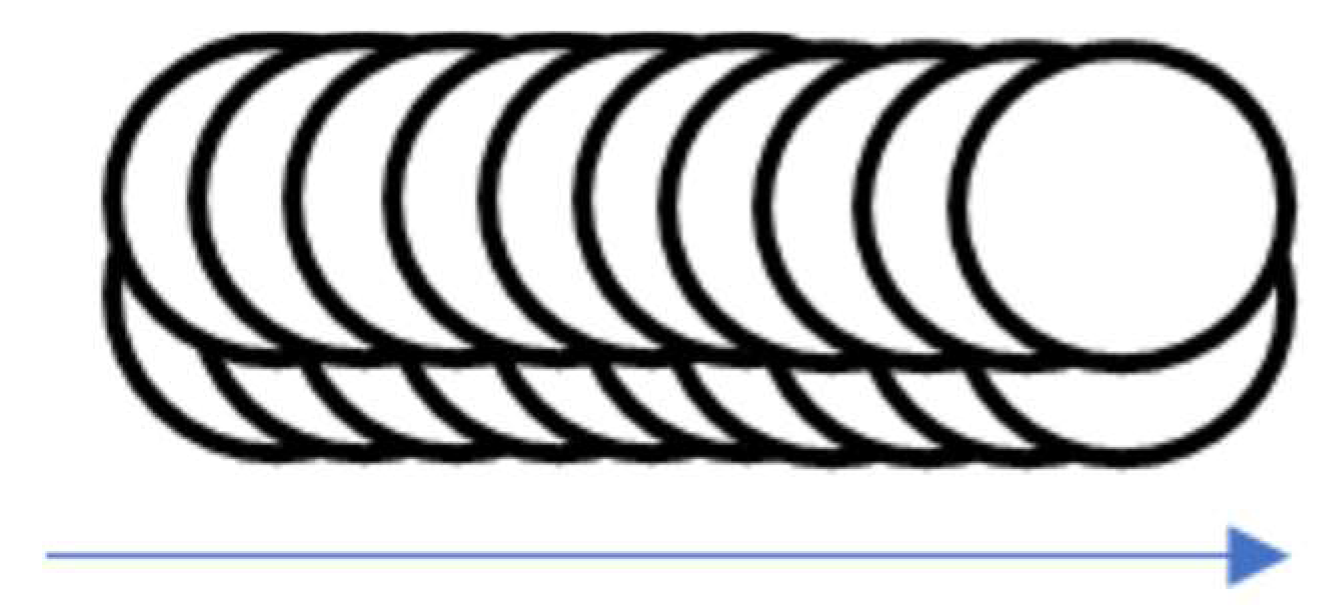
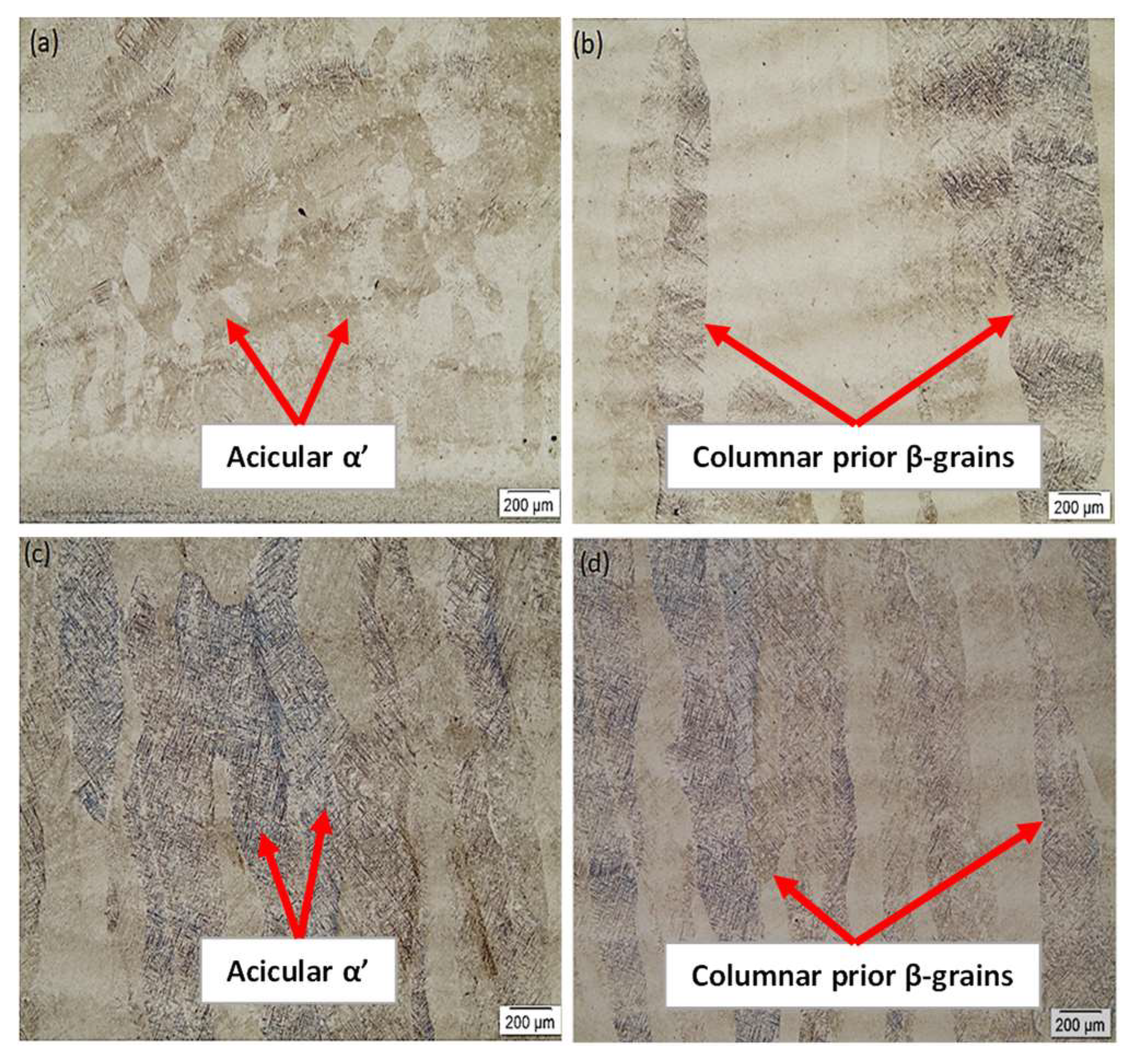
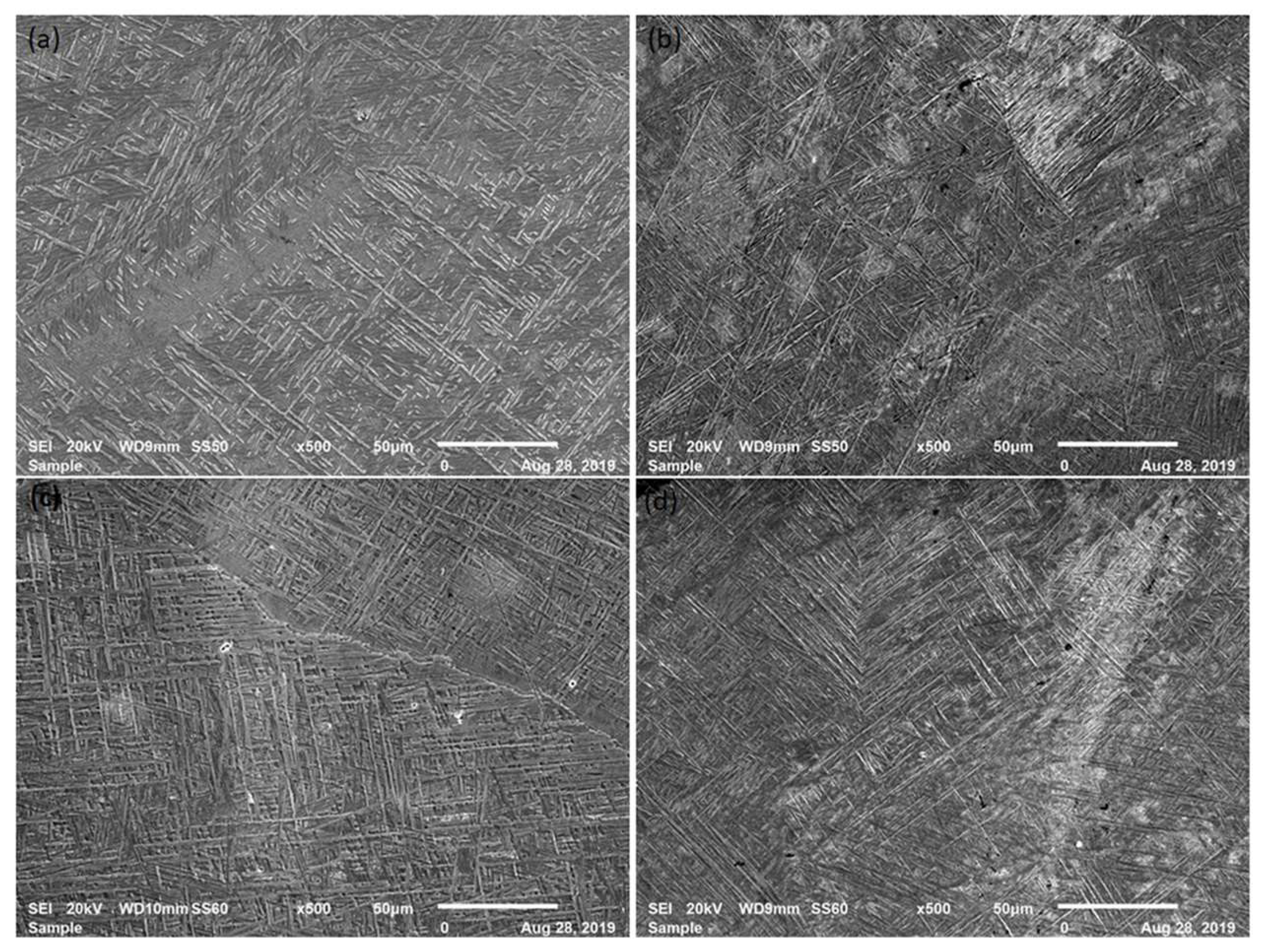
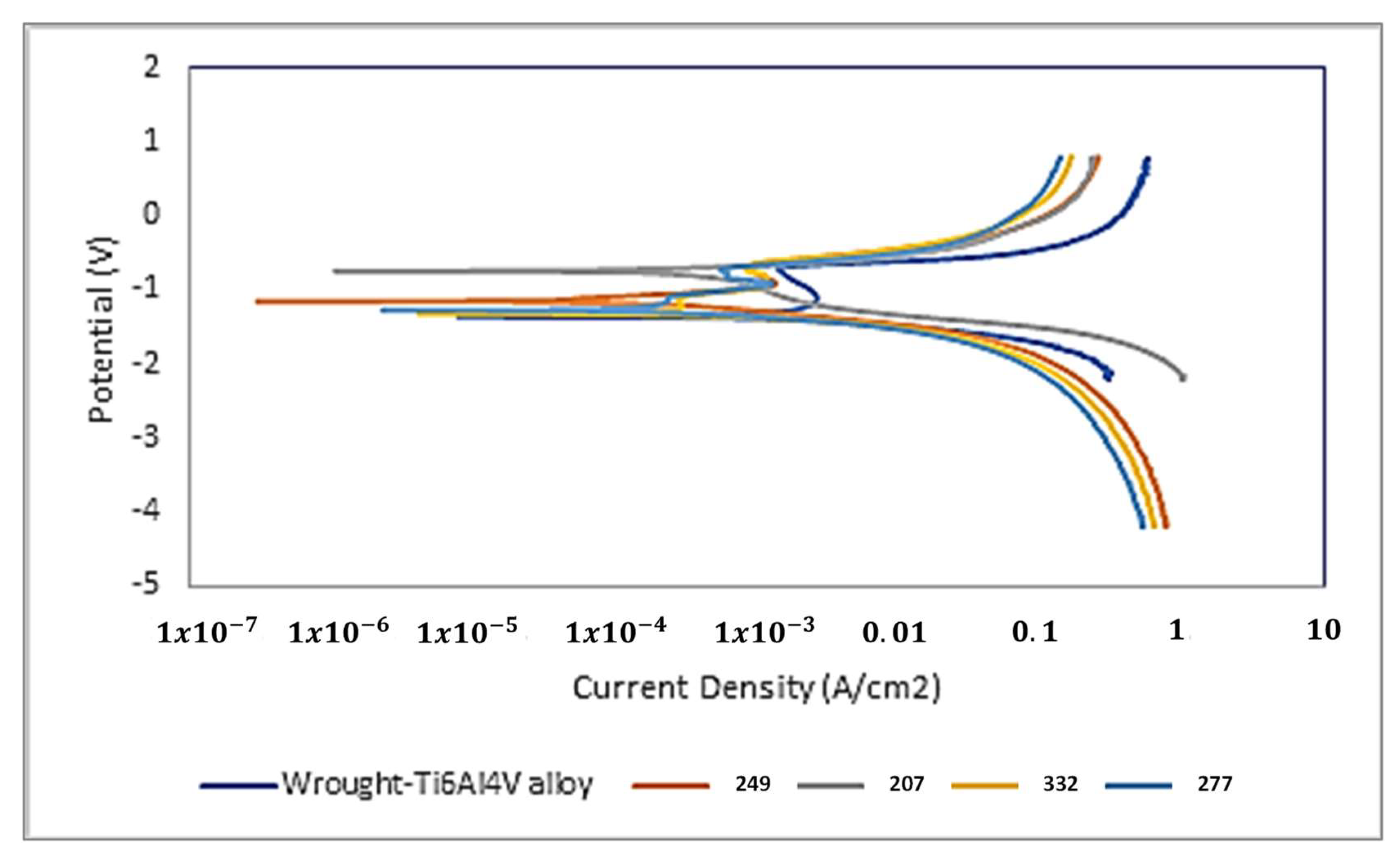


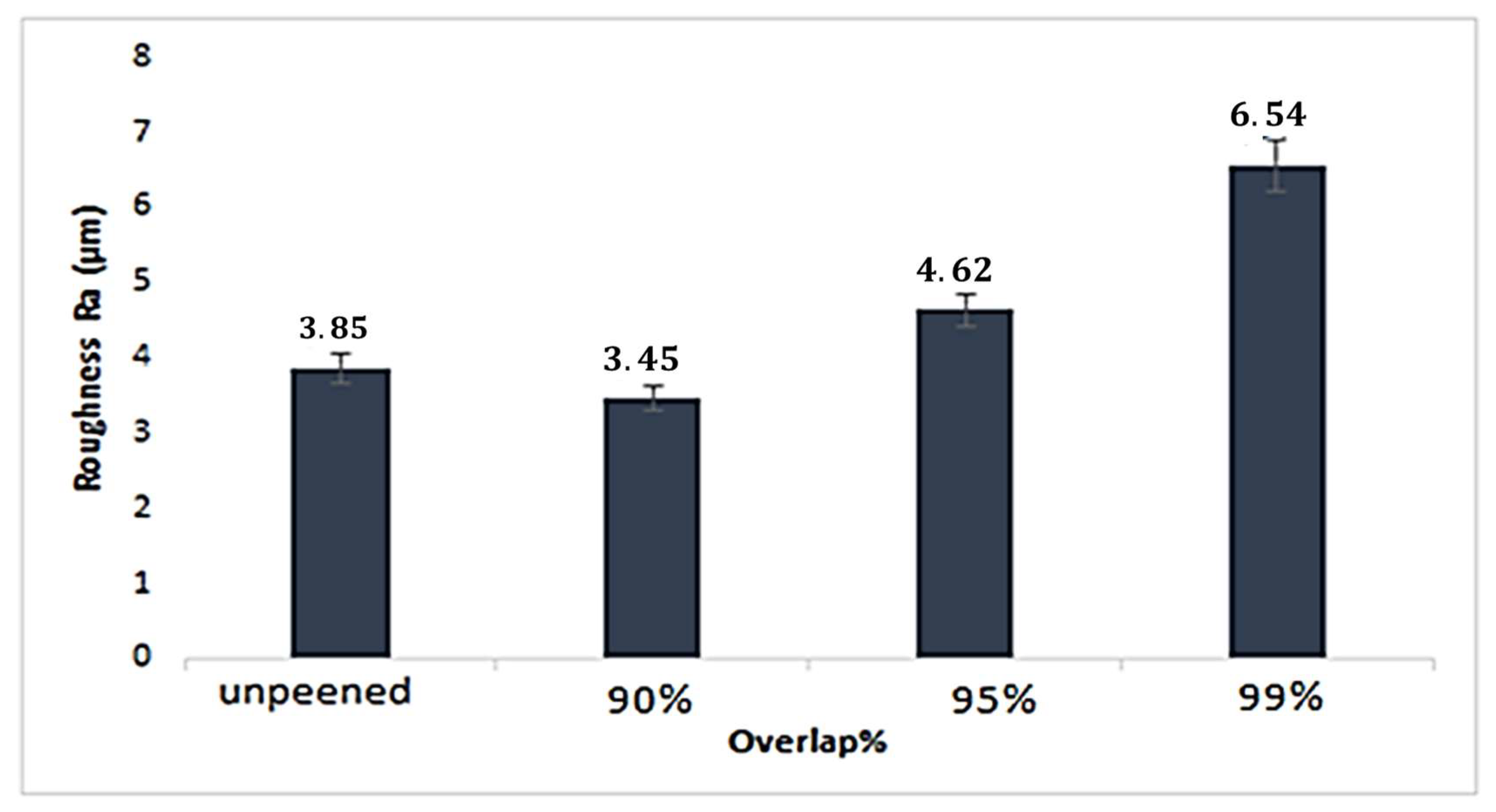
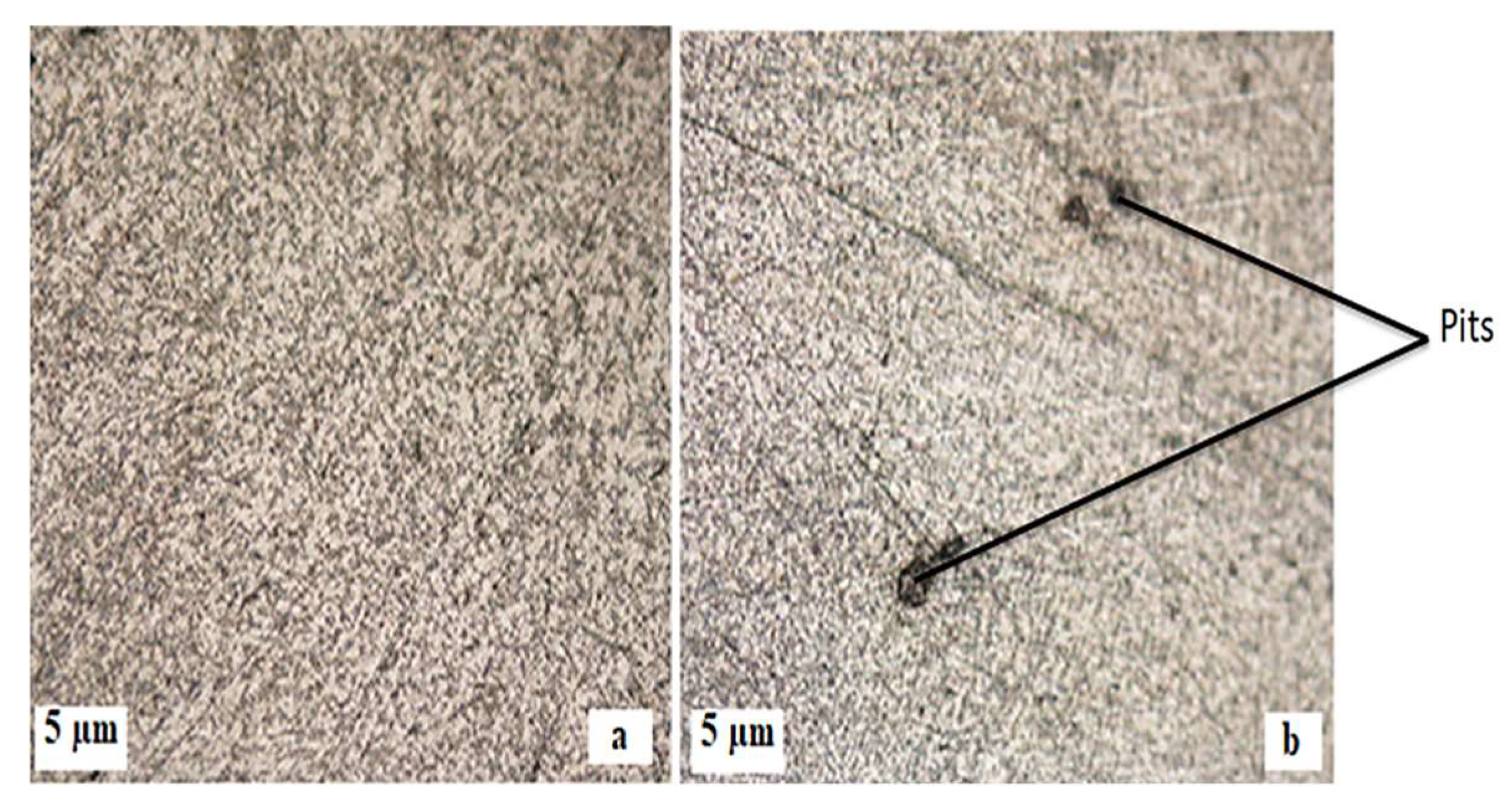

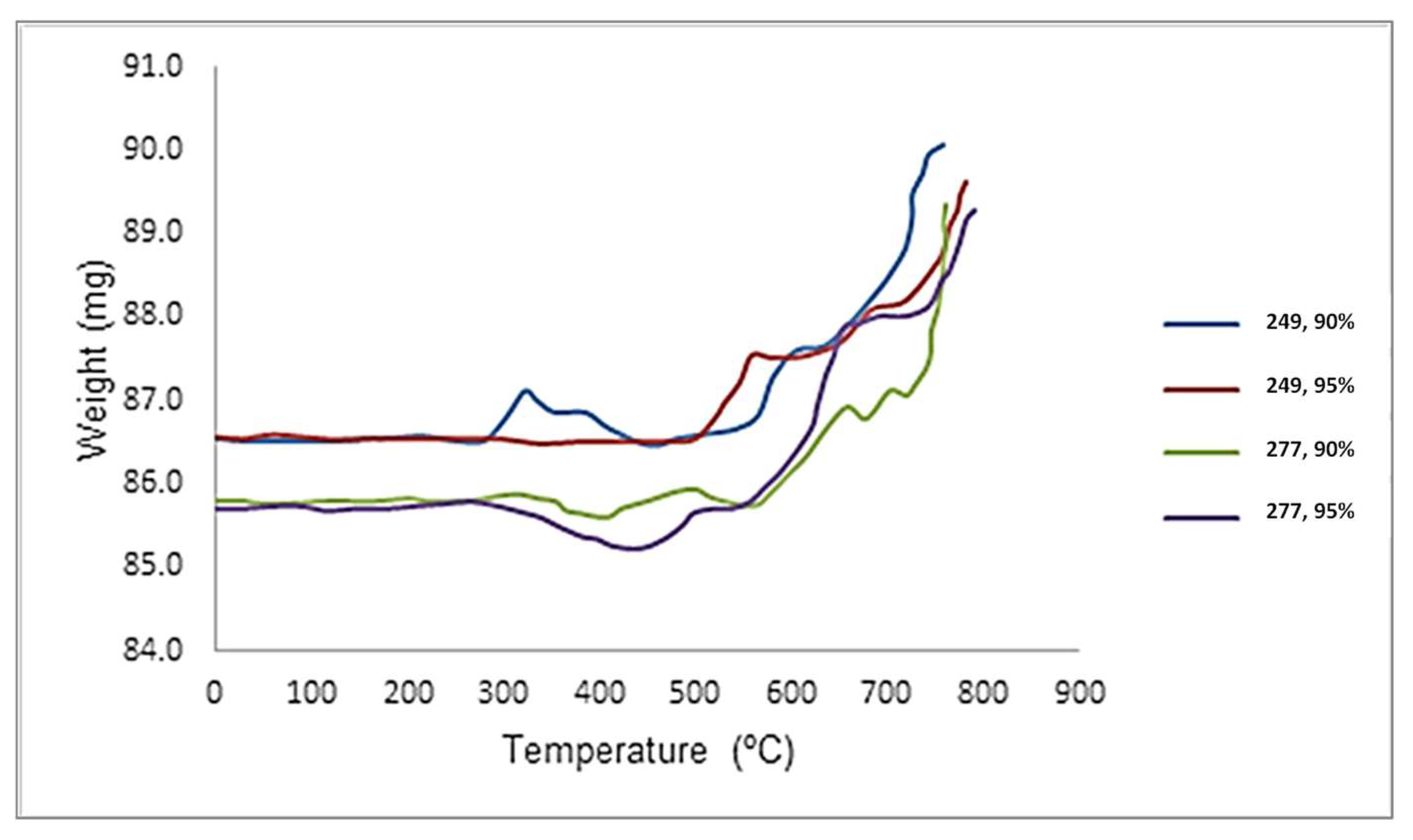
| Laser Energy Density (J/mm3) | Power (W) | Scan Speed (mm/s) | Hatch Spacing (mm) | Layer Thickness (mm) |
|---|---|---|---|---|
| 207 | 300 | 12.7 | 0.3375 | 0.3375 |
| 249 | 300 | 10.58 | ||
| 277 | 400 | 12.7 | ||
| 332 | 400 | 10.58 |
| Microhardness (HV0.3) | ||||
|---|---|---|---|---|
| Energy Density (J/mm3) | 207 | 249 | 277 | 332 |
| Maximum | 397 | 399 | 377 | 397 |
| Minimum | 320 | 303 | 330 | 330 |
| Average | 379 | 375 | 353 | 368 |
| STD dev | 15 | 17 | 11 | 12 |
| Samples (J/mm3) | Ecorr (V) | Icorr (A/cm²) | Corrosion Rate (mm/yr) | Polarisation Resistance (Ω) |
|---|---|---|---|---|
| Ti-6Al-4V Wrought | −1.3587 | 0.003224 | 1.2426 | 102.5 |
| 207 | −1.1523 | 0.001461 | 0.56302 | 168.776 |
| 249 | −0.74068 | 0.000842 | 0.32466 | 193.27 |
| 277 | −1.2709 | 0.002414 | 0.93023 | 117.06 |
| 332 | −1.3168 | 0.000854 | 0.3291 | 137.32 |
| Treatment | Ecorr (V) | Icorr (A/cm2) | Corrosion Rate (mm/yr) | Polarisation Resistance (Ω) |
|---|---|---|---|---|
| Un-peened | −0.67224 | 0.063 | 29,239 | |
| 90% overlap | −0.61981 | 0.004 | 40,932 | |
| 95% overlap | −0.59463 | 0.003 | 119,730 | |
| 99% overlap | −0.40481 | 0.005 | 12,220 |
Disclaimer/Publisher’s Note: The statements, opinions and data contained in all publications are solely those of the individual author(s) and contributor(s) and not of MDPI and/or the editor(s). MDPI and/or the editor(s) disclaim responsibility for any injury to people or property resulting from any ideas, methods, instructions or products referred to in the content. |
© 2023 by the authors. Licensee MDPI, Basel, Switzerland. This article is an open access article distributed under the terms and conditions of the Creative Commons Attribution (CC BY) license (https://creativecommons.org/licenses/by/4.0/).
Share and Cite
Arthur, N.K.K.; Kubjane, S.M.; Popoola, A.P.I.; Masina, B.N.; Pityana, S.L. The Effect of Laser Shock Processing on the Anti-Corrosion Performance of LENS-Fabricated Ti-6Al-4V Alloy. J. Compos. Sci. 2023, 7, 218. https://doi.org/10.3390/jcs7060218
Arthur NKK, Kubjane SM, Popoola API, Masina BN, Pityana SL. The Effect of Laser Shock Processing on the Anti-Corrosion Performance of LENS-Fabricated Ti-6Al-4V Alloy. Journal of Composites Science. 2023; 7(6):218. https://doi.org/10.3390/jcs7060218
Chicago/Turabian StyleArthur, Nana Kwamina Kum, Sharlotte Mamatebele Kubjane, Abimbola Patricia Idowu Popoola, Bathusile Nelisiwe Masina, and Sisa Lesley Pityana. 2023. "The Effect of Laser Shock Processing on the Anti-Corrosion Performance of LENS-Fabricated Ti-6Al-4V Alloy" Journal of Composites Science 7, no. 6: 218. https://doi.org/10.3390/jcs7060218
APA StyleArthur, N. K. K., Kubjane, S. M., Popoola, A. P. I., Masina, B. N., & Pityana, S. L. (2023). The Effect of Laser Shock Processing on the Anti-Corrosion Performance of LENS-Fabricated Ti-6Al-4V Alloy. Journal of Composites Science, 7(6), 218. https://doi.org/10.3390/jcs7060218







